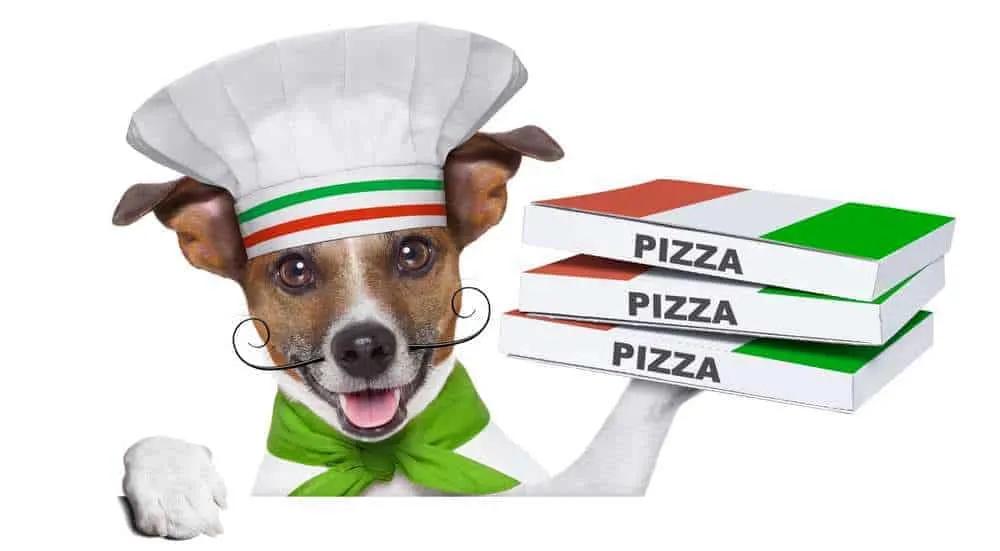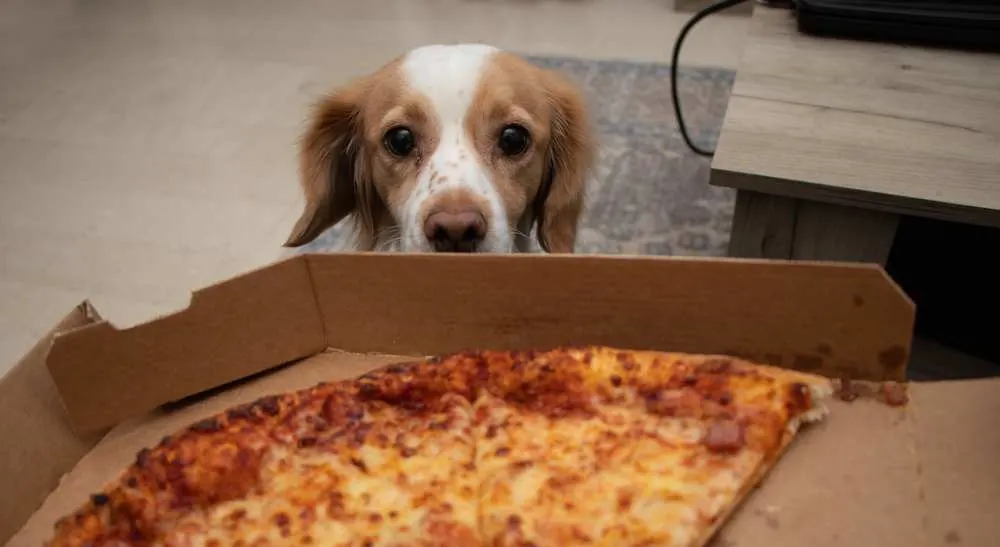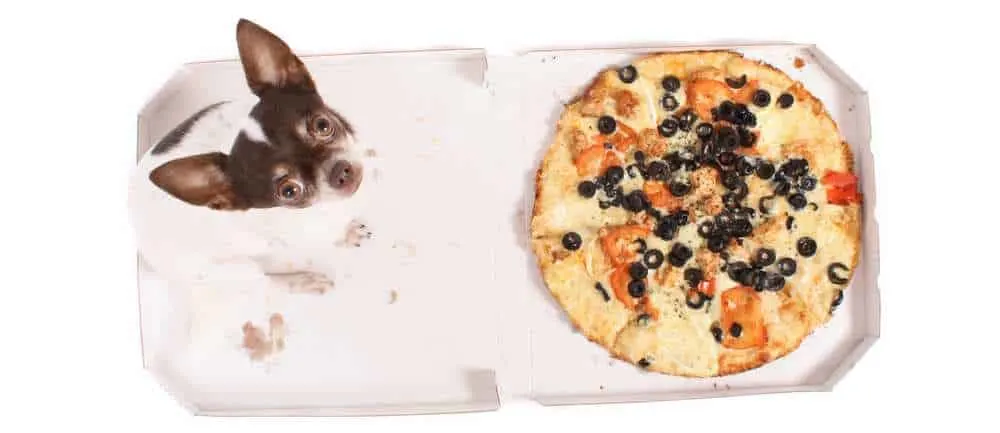Have you ever come home from a long day of work with a slice of hot pizza in your hands, and your dog just can’t keep its eyes from it? Well, freshly baked pizza is one of the most delicious things in the entire world, and it sure smells nice to your dog.
Or perhaps there are some cold leftovers from last night, as you didn’t quite manage to finish the pizza to the last bite. So, now you’re seriously considering giving your dog a leftover piece. Should you share a slice with your canine companion? Is it safe for dogs to eat pizza?
But most importantly – Can dogs eat pizza?
Luckily for you, we were also intrigued by this question, and so we’ve decided to dig a little deeper. We’ve come up with some interesting information, and the answers just might surprise you, so read along!

Can Dogs Eat Pizza?
You may be thinking – nothing that tastes this good can be bad for anyone, right? Well, that’s not entirely true. Feeding your dog pizza is not recommended. Sure, Toby will like the taste, and he will gladly eat it. But he might also later become sick.
Pizza has next-to none nutrition value for dogs. Therefore, they should not eat it. Dogs may like the taste, jump around, wag their tails, and give you the puppy face until you let them try some of that yummy treat. However, you will not make them any favors.
Let’s look at the nutritional value per one slice of regular cheese pizza (107g):
| Calories | 285 |
| Fat | 10,4 g |
| Sodium | 240 mg |
| Carbohydrates | 35,7 g |
| Fiber | 2,5 g |
| Sugars | 3,8 g |
| Protein | 12,2 g |
Pizza for dogs is like seasoned cardboard for humans. It may taste nice, and it will make you feel full, but you will not yield any benefits from it at all.
Besides, your dog can have severe reactions after eating a pizza. Some of the reactions are immediate, like sodium poisoning, some take effect later on, like garlic poisoning, and some are long-term like obesity.
Some of the pizza toppings can be beneficial when they are in their raw state (like tomato juice), but they become terrible for your dog when processed for pizza use. High sodium content in most toppings is a deal-breaker. Processed meats (like ham, bacon, and pepperoni) are exceptionally high in sodium levels and can potentially endanger your pup’s health.

Why Is Pizza Bad For Dogs?
Not all pizzas are the same, but they’re mostly made of the same ingredients – dough, sauce, and toppings. Most of them are harmful to your dog’s health.
Dough
The dough usually has ingredients that are high in sodium and carbohydrates. Both of these will make your dog obese. They have next to no nutrition value.
Sauce
Tomato sauce is a must-have on any pizza. It makes the pizza taste so good, but it is also bad for your dog for many reasons. Fresh tomato is not all that bad for your dog, but it becomes dangerous, even deadly when processed into the tomato sauce.
Salt, sugar, and other spices are added to the mix, making tomato sauce unsuitable for your dog. High sodium content can be very bad for your dog. It can cause gastrointestinal issues, heart diseases, and high blood pressure. Large quantities of sodium can even be deadly for your dog.
Cheese
Cheese is a dairy product, and most dogs have natural lactose intolerance, so any dairy products are harmful to them. Dogs are simply not designed to digest milk and dairy products. Most cheese that goes on a pizza is a high-fat percentage cheese, and that fat content is also dreadful for your dog.
Grease
Greasy food is often one of those guilty pleasures we have. Oil and grease mean there is an excess of fat. Even low-fat pizzas have some level of fat in them. Let’s face it; it’s one of those things that make a pizza taste so great.
For dogs, not so much. They will enjoy it, but it can cause some harm to them. It will wreak havoc on their digestive system. Dogs have a hard time losing fat content from their body. High levels of fat can lead to pancreatitis, which can be deadly for your dog. A healthy dog’s diet should consist of up to 10% fat.
Pepperoni
Humans have used salt since the dawn of time to preserve their meat. Today it is not only heavily salted, but all kinds of different preservatives come into play. Salami, pepperoni, ham, bacon, and anchovies are some of the toppings that are high in sodium and should never be given to a dog.
Garlic And Onions
Both of these are part of the allium family. They have a high concentration of thiosulfate. Thiosulfate is a known dog toxin, and it affects the oxygen in the red blood cells.
Even a small amount of these vegetables can cause severe problems for a dog’s cardiovascular system. Garlic and onions are added to the tomato sauce or the dough, so it is not easy to spot them every time. You may not instantly notice the symptoms of garlic or onion poisoning. They usually show after a few days, when it’s already too late.
The symptoms of garlic and onion poisoning include:
- Lethargy
- Depression
- Vomiting
- Loss of appetite
- Dehydration
- Abdominal pain
- Rapid breathing
- Jaundice
- Diarrhea
- Weakness
- Abnormal or red-colored urine
If you spot any of these symptoms, you should take your dog to the vet immediately and explain the symptoms you observed.

How About The Crust? Can Dogs Eat Pizza Crust?
Suppose you are already full, with the last slice in your hand, and perhaps there is a little crust left. Therefore, you think to yourself – hey, what’s the harm? Why shouldn’t Toby have this last piece?
Genuinely, that’s a big mistake, because the answer again is– no, dogs can’t eat pizza crust.
In fact, you won’t do your dog any favors if you give him the crust. The crust is exceptionally high in sodium and carbohydrates. These ingredients are not suitable for your dog.
They will not cause any immediate damage. However, sodium and carbs will indeed accumulate in your dog’s body and make him obese over time. Dogs naturally have a hard time losing body fat, and already obese dogs may start to have more severe health issues.

What Shall You Do If Your Dog Eats Pizza?
If you come home and catch sight of your dog eating a leftover pizza, you should take immediate action.
First and foremost, if your dog eats a slice or less, you should just observe it. Your dog may have some tummy ache, but it may just stop there.
Observation is the most important. If your dog seems absent or has trouble breathing or standing, it is time to take him to the vet.
On the other hand, if you know your dog has eaten a whole pizza or large portions of it, you should take him to the vet right away. Take as much information about the pizza he has eaten and its toppings as you can. You can even take a sample of pizza with you to the vet, so he can carefully examine any possible harmful ingredients.
Nevertheless, don’t panic as the vet will know what to do with your dog. He will inform you of the possible next steps in the treatment. Moreover, the vet will give you some useful advice about what to pay attention to if your dog is going to be treated at home.
If you want to give your dog some healthy snacks, choose some made specifically for dogs. There is an all-natural alternative like high-quality dog bones.
Bones have been dogs’ go-to food for eons. They will gladly chew on it for hours, and if they can’t gnaw on it in one sitting, they will bury it for later use. It’s hard to kick those basic instincts!

Conclusion
To summarize it all, it’s a big fat, greasy no. You should in no way give your dog a pizza to eat. Not even the crust.
Sure your dog will like it and want more, but it will only be bad for him or her. A slice may only give your dog a tummy ache, and more than a slice may hurt your dog’s tummy badly. Moreover, a prolonged pizza diet will definitely make your dog obese, and it might eventually be fatal.
So keep pizza for yourself and your friends, and give your dog a bone or any treat made for dogs, not humans.
Learn More: What Can Dogs Eat? A Comprehensive List Of Dog-safe Foods

